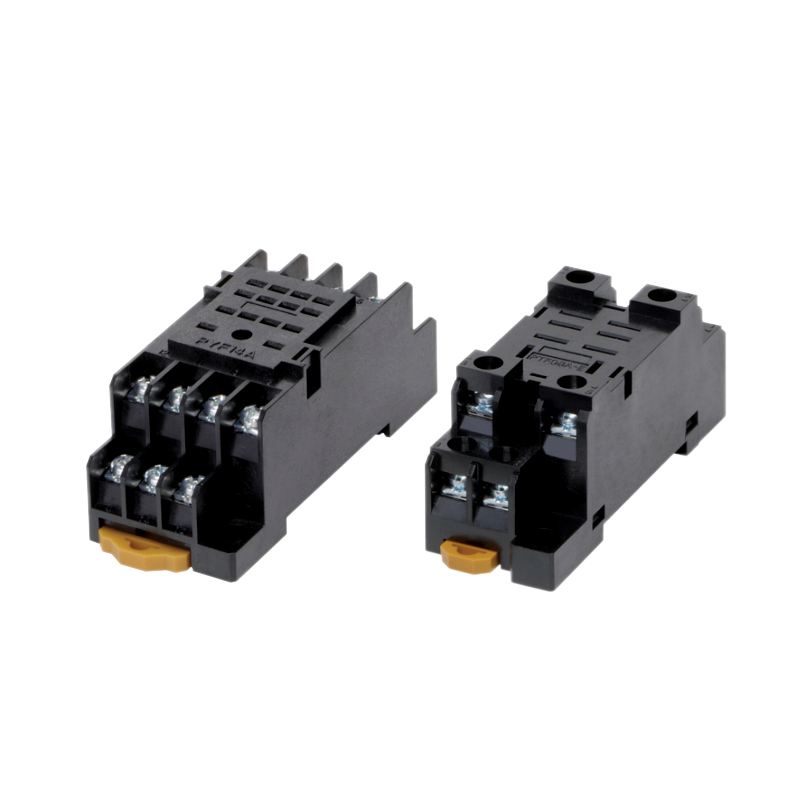A relay is an electrically operated switch. It consists of a set of input terminals for a single or multiple control signals, and a set of operating contact terminals. The switch may have any number of contacts in multiple contact forms, such as make contacts, break contacts, or combinations thereof.
Relays are used where it is necessary to control a circuit by an independent low-power signal, or where several circuits must be controlled by one signal. Relays were first used in long-distance telegraph circuits as signal repeaters: they refresh the signal coming in from one circuit by transmitting it on another circuit. Relays were used extensively in telephone exchanges and early computers to perform logical operations.
The traditional form of a relay uses an electromagnet to close or open the contacts, but relays using other operating principles have also been invented, such as in solid-state relays which use semiconductor properties for control without relying on moving parts. Relays with calibrated operating characteristics and sometimes multiple operating coils are used to protect electrical circuits from overload or faults; in modern electric power systems these functions are performed by digital instruments still called protective relays.
Latching relays require only a single pulse of control power to operate the switch persistently. Another pulse applied to a second set of control terminals, or a pulse with opposite polarity, resets the switch, while repeated pulses of the same kind have no effects. Magnetic latching relays are useful in applications when interrupted power should not affect the circuits that the relay is controlling.

History
Exclamation mark with arrows pointing at each other
This section appears to contradict itself. Please see the talk page for more information. (September 2021)
Telegraph relay contacts and spring
In 1809 Samuel Thomas von Sömmerring designed an electrolytic relay as part of his electro-chemical telegraph.
Solely electrical relays got their start as a further improvement to telegraphs, with American scientist Joseph Henry who is often cited to have invented a relay in 1835 in order to improve his version of the electrical telegraph, developed earlier in 1831.
However, an official patent wasn't issued until 1840 to Samuel Morse for his telegraph, which is now called a relay. The mechanism described acted as a digital amplifier, repeating the telegraph signal, and thus allowing signals to be propagated as far as desired.
The word relay appears in the context of electromagnetic operations from 1860 onwards.
Basic design and operation
Operation with flyback diode, arcing in the control circuit is avoided
A simple electromagnetic relay consists of a coil of wire wrapped around a soft iron core (a solenoid), an iron yoke which provides a low reluctance path for magnetic flux, a movable iron armature, and one or more sets of contacts (there are two contacts in the relay pictured). The armature is hinged to the yoke and mechanically linked to one or more sets of moving contacts. The armature is held in place by a spring so that when the relay is de-energized there is an air gap in the magnetic circuit. In this condition, one of the two sets of contacts in the relay pictured is closed, and the other set is open. Other relays may have more or fewer sets of contacts depending on their function. The relay in the picture also has a wire connecting the armature to the yoke. This ensures continuity of the circuit between the moving contacts on the armature, and the circuit track on the printed circuit board (PCB) via the yoke, which is soldered to the PCB.
When an electric current is passed through the coil it generates a magnetic field that activates the armature, and the consequent movement of the movable contact(s) either makes or breaks (depending upon construction) a connection with a fixed contact. If the set of contacts was closed when the relay was de-energized, then the movement opens the contacts and breaks the connection, and vice versa if the contacts were open. When the current to the coil is switched off, the armature is returned by a force, approximately half as strong as the magnetic force, to its relaxed position. Usually this force is provided by a spring, but gravity is also used commonly in industrial motor starters. Most relays are manufactured to operate quickly. In a low-voltage application this reduces noise; in a high voltage or current application it reduces arcing.
When the coil is energized with direct current, a flyback diode or snubber resistor is often placed across the coil to dissipate the energy from the collapsing magnetic field (back EMF) at deactivation, which would otherwise generate a voltage spike dangerous to semiconductor circuit components. Such diodes were not widely used before the application of transistors as relay drivers, but soon became ubiquitous as early germanium transistors were easily destroyed by this surge. Some automotive relays include a diode inside the relay case. Resistors, while more durable than diodes, are less efficient at eliminating voltage spikes generated by relays and therefore not as commonly used.
If the relay is driving a large, or especially a reactive load, there may be a similar problem of surge currents around the relay output contacts. In this case a snubber circuit (a capacitor and resistor in series) across the contacts may absorb the surge. Suitably rated capacitors and the associated resistor are sold as a single packaged component for this commonplace use.
If the coil is designed to be energized with alternating current (AC), some method is used to split the flux into two out-of-phase components which add together, increasing the minimum pull on the armature during the AC cycle. Typically this is done with a small copper "shading ring" crimped around a portion of the core that creates the delayed, out-of-phase component,which holds the contacts during the zero crossings of the control voltage.
Contact materials for relays vary by application. Materials with low contact resistance may be oxidized by the air, or may tend to "stick" instead of cleanly parting when opening. Contact material may be optimized for low electrical resistance, high strength to withstand repeated operations, or high capacity to withstand the heat of an arc. Where very low resistance is required, or low thermally-induced voltages are desired, gold-plated contacts may be used, along with palladium and other non-oxidizing, semi-precious metals. Silver or silver-plated contacts are used for signal switching. Mercury-wetted relays make and break circuits using a thin, self-renewing film of liquid mercury. For higher-power relays switching many amperes, such as motor circuit contactors, contacts are made with a mixtures of silver and cadmium oxide, providing low contact resistance and high resistance to the heat of arcing. Contacts used in circuits carrying scores or hundreds of amperes may include additional structures for heat dissipation and management of the arc produced when interrupting the circuit.Some relays have field-replaceable contacts, such as certain machine tool relays; these may be replaced when worn out, or changed between normally open and normally closed state, to allow for changes in the controlled circuit.
 繁體(台灣)
繁體(台灣) 简体中文
简体中文 USA(English)
USA(English) Vietnam
Vietnam